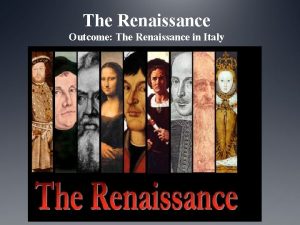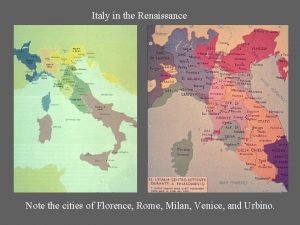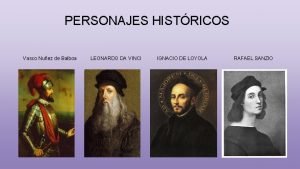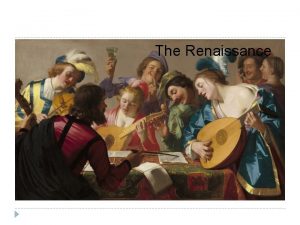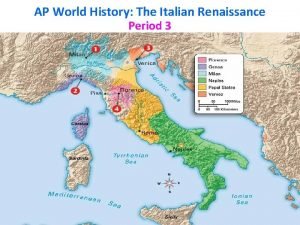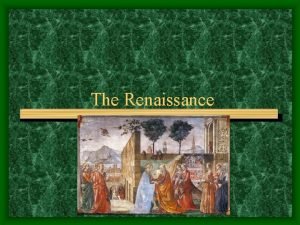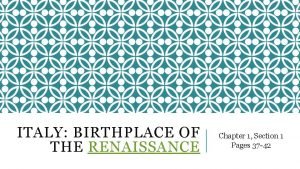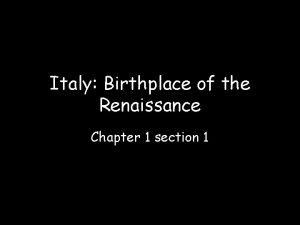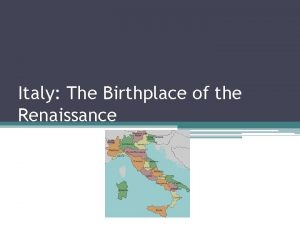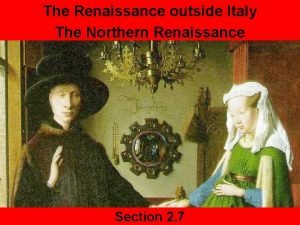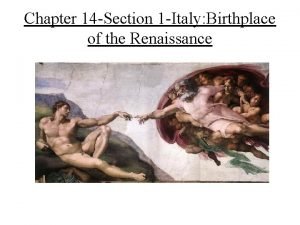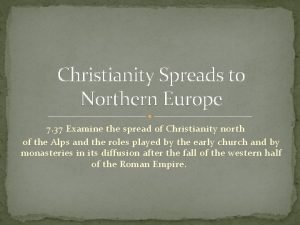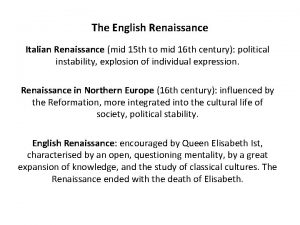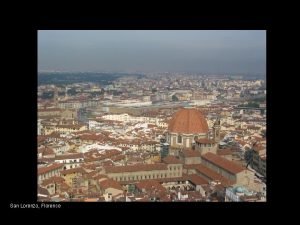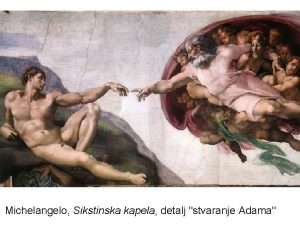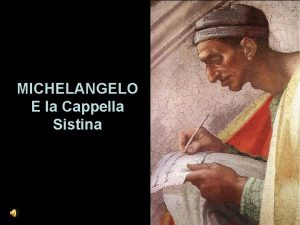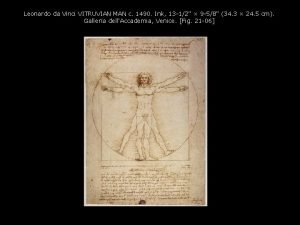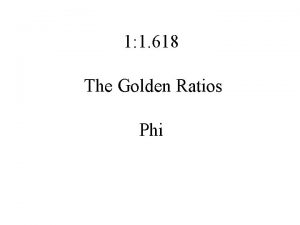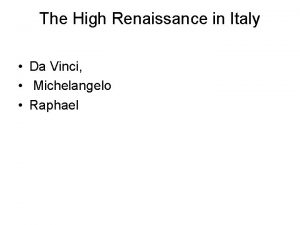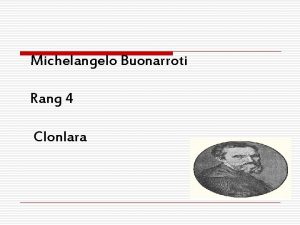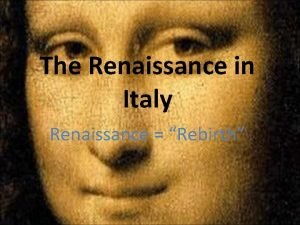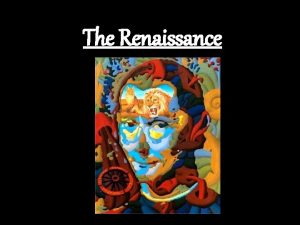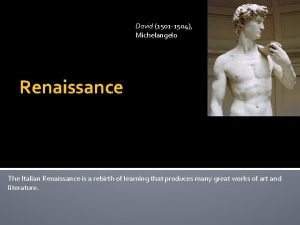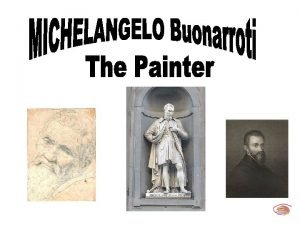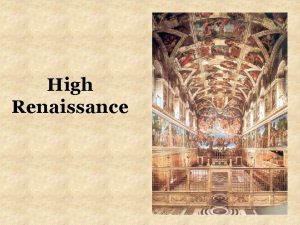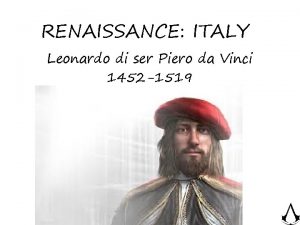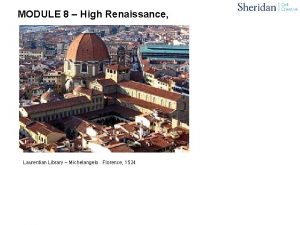The High Renaissance in Italy Da Vinci Michelangelo

























































































- Slides: 89

The High Renaissance in Italy • Da Vinci, • Michelangelo • Raphael

Leonardo da Vinci – the Renaissance Man

• The term “renaissance man” is used to describe someone who has a wide variety of interests, and expertise in many fields. • Leonardo da Vinci was the quintessential renaissance man. He was a painter, sculptor, inventor, architect, musician, engineer, and scientist. • He is widely recognized as a genius of the highest level. • Historians tell us that he was not only intellectually gifted, but that he was noble in appearance and manners as well.

Leonardo da Vinci The Last Supper 1495 - 1498

• Thank you Samantha and Lauren for introducing this work to us.

• The Last Supper was painted on the wall of the refectory (dining hall) in the monastery of Santa Maria delle Grazie in Milan, Italy • The Last Supper measures 450 × 870 centimeters (15 feet × 29 ft)

• Christ is depicted here with his disciples at the last meal he shared with them before his crucifixion. We are shown the moment after Jesus has announced that one of the disciples will betray him. • The disciples react with dismay, and their gestures show their disbelief and concern.

• Notice how effectively Da Vinci leads the viewer’s eye to Jesus: – By centering Jesus – By using the lines of perspective in the walls and ceiling – By framing Jesus’ head in the window – By isolating Jesus, while all other figures are grouped and overlapping – By following the gazes and gestures of the disciples – By contrasting Jesus’ stillness with the agitation of the other figures

Disasters plague The Last Supper • The Last Supper is one of the most famous paintings in the world, but it has not been well preserved. • Shortly after Da Vinci finished the painting it began to peel off the wall. (Da Vinci did not use the fresco technique; instead, he sealed the surface of the wall and painted on top of it. ) • Several attempts by lesser artists were made to restore it, and parts of it were painted over with oil paints. • At one point a door was cut into the wall below the picture, partly cutting off the bottom of the painting. • During the Napoleonic wars, when the monastery was used as an armory, soldiers threw their boots at Judas. • During WWII, the dining hall suffered a direct hit in a Nazi bombing raid. • The painting was covered by a canvas, but trapped moisture caused fungus to grow on the surface of the painting.

Leonardo da Vinci Mona Lisa (La Giaconda) 1503

• Mona was an abbreviation of madonna, meaning “my lady, ” the equivalent of Madame, or Signora. So the title means Madame Lisa. • Lisa became the wife of a Florentine silk merchant at the age of 16. She was 24 years old when the portrait was completed. • Da Vinci worked on it for four years and kept it with him until he died at age 50.

• The painting was stolen from the Louvre in 1911 by a former Louvre employee and rediscovered in a hotel room in Florence 2 years later.

Mona Lisa, A Prototype for Renaissance Portraiture • The portrait is a prototype of the Renaissance portrait. In other words, Da Vinci introduced a new way of painting portraits. • He used both linear and aerial perspective in the background • He used a relaxed, natural, three-quarter pose which was a departure from the stiff profile head and shoulders portraits which had become the norm at that time. • He used a technique known as sfumato, (smoke) building the painting with layers of semi-transparent glazes, so the expression on the model’s face, especially her smile, is softly ambiguous, or mysterious.

Leonardo da Vinci The Madonna of the Rocks

• There are 2 versions of this painting, one in the Louvre, in Paris, and one at the National Gallery, in London. • The scene refers to a legend that Jesus and John the Baptist met up as infants on the road to Egypt, fleeing Herod’s decree that all Jewish infants under the age of two years must be murdered.

• The cross and halos that are absent in the first version (the Louvre version) were possibly added to the London version by another artist, to make identification of the two child figures easier. • The pool of water foreshadows John’s role as the one who will baptize Jesus.

Leonardo da Vinci The Virgin and St. Anne • Da Vinci shows us three generations of the Holy Family here in an intimate and relaxed moment. The Virgin Mary sits in her mother’s lap (St. Anne), and reaches lovingly toward Jesus, who plays with a lamb. The lamb, of course, symbolizes Jesus’ future role as a sacrifice for all mankind.

Leonardo da Vinci Cecilia Gallerani 1489 - 1490

• The Lady with the Ermine was painted in oils on wooden panel • Cecilia Gallerani was the mistress of Leonardo's employer, Lodovico Sforza • At the time of her portrait, Cecilia was about sixteen. • was renowned for her beauty, her scholarship, and her poetry. She was betrothed at the age of about ten years to a young nobleman of the house of Visconti but the marriage was called off. Cecilia became the mistress of the Duke and bore him a son, but he chose to marry a girl from a more noble family, Beatrice d'Este. [3]

• Cecilia's dress is comparatively simple, revealing that she is not a noblewoman. Her coiffure, known as a "coazone", confines her hair smoothly to her head with two bands of hair bound on either side of her face and a long plait at the back. Her hair is held in place by a fine gauze veil with a woven border of gold-wound threads, a black band a sheath over the plait.

Why an Ermine? • There are several interpretations of the significance of the ermine in her portrait. The ermine was a traditional symbol of purity because it was believed that an ermine would face death rather than soil its white coat by hiding in a muddy burrow. • For Ludovico il Moro the ermine had a further personal significance in that he had been in the Order of the Ermine in 1488 and used it as a personal symbol. • Given that Cecilia gave birth to a son acknowledged by Lodovico in May of 1491, and the association of weasels and pregnancy in Italian Renaissance culture, it is also possible that the animal was a symbol of Cecilia's pregnancy.

Leonardo da Vinci – La Belle Ferroniere

• This is one of only four portraits of women by Leonardo da Vinci. • It is thought by some art historians that this woman was another mistress of the Duke of Milan.

Leonardo da Vinci • Vitruvian Man 1487 • The Vitruvian Man remains one of the most referenced and reproduced artistic images in the world today.

• Vitruvian Man is a world-renowned drawing created by Leonardo da Vinci around the year 1487. It is accompanied by notes based on the work of the famed classical architect, Vitruvius, for which it is named. • The drawing and text are sometimes called the Canon of Proportions or, less often, Proportions of Man.

• According to Leonardo's notes, (written in mirror writing), it was made as a study of the proportions of the (male) human body as described in Vitruvius. For example: – the length of a man's outspread arms (arm span) is equal to his height – the distance from the top of the head to the bottom of the chin is one-eighth of a man's height etc. (ie. The figure is 8 heads high)

the • The Renaissance was a period in which the human form was recognized as noble, made in the image of God. Mankind was seen as “the measure of all things, ” and human proportions were thought to correspond with measurements found in the natural world and in the structure of the universe

Leonardo da Vinci drawing of a woman’s head

Da Vinci the medical researcher – study of a fetus

Leonardo da Vinci anatomical drawing – human lungs

Da Vinci the inventor – sketch design of a helicopter

Michelangelo Sculptor Painter Architect

• "In every block of marble I see a statue as plain as though it stood before me, shaped and perfect in attitude and action. I have only to hew away the rough walls that imprison the lovely apparition to reveal it to the other eyes as mine see it. "—Michelangelo

• Michelangelo’s David. • This statue is perhaps the most iconic image of the Renaissance period. • Michelangelo’s statue stands 17 feet high (about 3 metres)

• "In it may be seen most beautiful contours of legs, with attachments of limbs and slender outlines of flanks that are divine; nor has there ever been seen a pose so easy, or any grace to equal that in this work, or feet, hands and head so well in accord, one member with another, in harmony, design, and excellence of artistry. And, of a truth, whoever has seen this work need not trouble to see any other work executed in sculpture, either in our own or in other times, by no matter what craftsman. " Giorgio Vasari 1550


Michelangelo’s David • It was sculpted between 1501 and 1504. • Michelangelo was only twenty-six years old, when he won the commission to complete the statue from a block of marble (the giant) that had been abandoned 30 years earlier by another artist. • When it was finished, David was placed in front of the entrance to the Palazzo Vecchio, the town hall. In 1873 the statue was moved from the piazza, to protect it from damage, and brought to its current location in the Academia Gallery, in Florence.

A Classic Pose • David is a Renaissance interpretation of a common ancient Greek theme of the standing heroic male nude. • In the High Renaissance, contrapposto poses were thought of as a distinctive feature of antique sculpture. In David, the figure stands with one leg holding its full weight and the other leg relaxed. This classic pose causes the figure’s hips and shoulders to rest at opposite angles, giving a slight s-curve to the entire torso. This curve gives the figure its classical grace. • Michelangelo’s David has become one of the most recognized pieces of Renaissance sculpture, becoming a symbol of both strength and youthful human beauty.


• Traditionally, David was portrayed after his victory, triumphant over the giant Goliath. Both Verrochio’s and Donatello’s Davids are depicted standing over Goliath's severed head. • Michelangelo has depicted David before the battle. Davis is tense, but not so much in a physical as in a mental sense. The slingshot he carries over his shoulder is almost invisible, emphasizing that David's victory was one of cleverness, not sheer force.

• The hand that holds the stone is larger than the other, drawing the viewer’s attention to the action that is about to unfold.

Facing down the enemy • Michelangelo was a citizen of the city state of Firenze (Florence), and Florence was surrounded by much more powerful enemy city states. • When the statue of David was placed on the square in front of the city hall, the people of Florence immediately identified with him as the cunning underdog triumphing over the big bad guy. David was positioned so that his glare was directed south, toward the rival city of Rome.


Michelangelo - Moses

Michelangelo’s Moses • This statue was commissioned by Pope Julius II for Julius’ tomb. • It was one of 40 figures that were intended to adorn the tomb in St. Peter’s Basilica. The tomb ended up in a smaller church, with only a third of the originally planned figures.

Moses • Moses, sculpted in marble, has horns on his head, in the manner that was traditional in medieval depictions of Moses (tongs of fire according to the bible). • Horns were symbolic of authority in ancient Near Eastern culture, and the medieval depiction had the advantage of giving Moses a convenient attribute by which he could easily be recognized in crowded pictures.


Michelangelo – Pieta


Pieta • Pieta means ‘Pity, ’ and this is certainly the emotion that this magnificent sculpture evokes. • We feel pity for Christ’s suffering, but also for his grieving mother, who holds her son’s body in an attitude of quiet acceptance.

Michelangelo’s Pieta • The Pieta balances the Renaissance ideals of classical beauty with naturalism. The statue is one of the most highly finished works by Michelangelo. • The structure is pyramidal. The statue widens progressively down the drapery of Mary's dress, to the base. The figures are quite out of proportion, owing to the difficulty of depicting a fully-grown man cradled full-length in a woman's lap. By concealing much of Mary's body in her monumental drapery, Michelangelo made the relationship of the figures appear quite natural.


• Note that Michelangelo's sculpted a young and beautiful Mary rather than an older woman. One explanation for this is that her youth symbolizes her incorruptible purity. Another is that Mary is really seeing her child, the infant Jesus, while the viewer is seeing an image of the future. • The marks of the crucifixion are limited to very small nail marks and an indication of the wound in Jesus' side.



Michelangelo as a Painter: The Sistine Chapel • The Sistine Chapel is located in the Vatican City in Rome, attached to St. Peter’s Basilica, the papal apartments and the vast complex of buildings that make up the Vatican museums. • Michelangelo was commissioned by Pope Julius II to paint the ceiling of the chapel. He resisted, as he preferred sculpture to painting, but had to do as he was told. • The works are frescoes, (painted into fresh plaster) and they cover about 4, 000 square metres of ceiling. • Michelangelo built scaffolding so that he could work on his back, and laboured over the frescoes from 1508 to 1512.

Michelangelo The Sistine Chapel

Michelangelo The Creation of Adam (The Sistine Chapel)

• Thank you Jon, for introducing this work to us.

Interpretations of The Creation of Adam • It has been suggested that the background figures and shapes portrayed behind the figure of God bear a striking similarity to a cross section of the human brain, including the frontal lobe, optic chiasm, brain stem, pituitary gland, and the major sulci of the cerebrum. • Alternatively, it has been observed that the red cloth around God has the shape of a human uterus and that the scarf hanging out, colored green, could be a newly cut umbilical cord.

• Both of these interpretations suggest the mystery of creation – in the mind, where ideas are born, and in the womb, where life originates. • The painting depicts the symbolic birth of the human race, as God reaches out to give the breath of life to Adam, the first man, reclining on the newly made earth. • Under God’s left arm is Eve, as yet unborn. • Michelangelo’s fascination with and his familiarity with human anatomy are in evidence here.

Sistine Chapel – The Temptation of Adam and Eve (The Sistine Chapel)

Michelangelo – The Sistine Chapel The Last Judgment

• The Last Judgment is on the altar wall of the Sistine Chapel. It took four years to complete(1537 to 1541). Michelangelo began working on it three decades after finishing the ceiling of the chapel. • The work is massive and spans the entire wall behind the altar of the Sistine Chapel. The Last Judgment is a depiction of the Second Coming of Christ and the apocalypse. The souls of humans rise and descend to their fates, as judged by Christ surrounded by his saints.

• The Last Judgment was a source of conflict between Cardinal Carafa and Michelangelo: the artist was accused of obscenity, having depicted naked figures, inside the most important church of Christianity, ) • When the Pope's own Master of Ceremonies, Biagio da Cesena, said that it was no work for a papal chapel but rather "for the public baths and taverns, " Michelangelo worked Cesena's face into the scene as Minos, judge of the underworld (far bottom-right corner of the painting) with Donkey ears {i. e. foolishness} while his nudity is covered by a coiled snake. • It is said that when Cesena complained to the Pope, the pontiff joked that his jurisdiction did not extend to hell, so the portrait would have to remain

Detail from The Last Judgement – “Minos”

• In the painting, Michelangelo does a self portrait depicting himself as St. Bartholomew after he had been flayed (skinned alive). This is reflective of the feelings of contempt Michelangelo had for being commissioned to paint The Last Judgement.



Michelangelo as an Architect: The dome of St. Peter’s in Rome




• The dome of St. Peter’s Basilica, Rome

St Peter’s Square - Rome

Raphael Sanzo • 8 years younger than Michelangelo • Interested in archeology, he became an expert in ancient Roman art. • Commissioned to decorate the state rooms in the Vatican at the same time that Michelangelo was working on the Sistine Chapel frescoes.

• Raphael, unlike Michelangelo, was well mannered, well dressed, well liked. • He always carried around a sketch book in which he constantly sketched women and children. These sketches formed the basis of his many Madonnas. • He was influenced by Perugino to use soft colours, simple circular forms, and gentle landscapes in his paintings. • He is best remembered for his madonnas, his portrayals of the Virgin with the infant Jesus.

The Sistine Madonna

Raphael – The Sistine Madonna (detail of the angels)

• Raphael’s madonnas seem simple and effortless, but their apparent simplicity is the fruit of deep thought, careful planning and immense artistic wisdom. A painting like Raphael's 'Madonna dell Granduca', is truly 'classical' in the sense that it has served countless generations as a standard of perfection in the same way as the works of the classical sculptors Pheidias and Praxiteles.

• The Madonna del Granduca • The way the Virgin's face is modeled and recedes into the shade, the way Raphael makes us feel the volume of the body wrapped in the freely flowing mantle, the firm and tender way in which she holds and supports the Christ Child - all this contributes to the effect of perfect poise…to change the group ever so slightly would upset the whole harmony. Yet there is nothing strained or sophisticated in the composition. It looks as if it could not be otherwise, and as if it had so existed from the beginning of time.

Raphael – Madonna della Sedia - 1514

Raphael – The Alba Madonna 1500

Raphael – The Madonna of the Meadow 1505

• Raphael – The Cowper Madonna. • 1505

Raphael – The School at Athens

• Thank you Erica and Chiara for introducing us to this work.

Raphael – The School at Athens. 1509 -1510 • Raphael’s famous fresco decorates a wall in the papal palace at the Vatican, in Rome. • He depicts famous figures from various fields of knowledge, with the Greek philosophers, Plato and Aristotle at the centre of the composition. Plato is shown with Leonardo da Vinci’s features. • Also included in the painting are Socrates (another philosopher), Alexander the Great (military genius) and Pythagoras and Euclid (mathematicians).

• Raphael has also paid tribute to his fellow artist, Michelangelo, by placing him in the foreground. • The work is a brilliant demonstration of the technique of linear (line) perspective. The architectural space recedes infinitely through the arches of the marble hall to the open sky beyond.
 Leonardo da vinci the last supper painting
Leonardo da vinci the last supper painting Leonardo da vinci was born on 15 april 1452 near
Leonardo da vinci was born on 15 april 1452 near Causes of renaissance
Causes of renaissance The renaissance outcome the renaissance in italy
The renaissance outcome the renaissance in italy Michelangelo vs da vinci
Michelangelo vs da vinci Last supper labeled
Last supper labeled Leonardo da vinci violante di ser piero da vinci
Leonardo da vinci violante di ser piero da vinci Why was italy the birthplace of the renaissance
Why was italy the birthplace of the renaissance What years did the renaissance take place
What years did the renaissance take place What started the renaissance
What started the renaissance Where did the renaissance begin
Where did the renaissance begin Renaissance italy city states
Renaissance italy city states In the prince machiavelli advises rulers to
In the prince machiavelli advises rulers to Renaissance clothing italy
Renaissance clothing italy Humanism ap world history
Humanism ap world history Renaissance begins in italy
Renaissance begins in italy Chapter 13 section 1 the renaissance in italy
Chapter 13 section 1 the renaissance in italy Birthplace of italian renaissance
Birthplace of italian renaissance Italy birthplace of the renaissance
Italy birthplace of the renaissance Mikelandjelo slikar
Mikelandjelo slikar Why was italy the birthplace of the renaissance
Why was italy the birthplace of the renaissance Characteristics of the northern renaissance
Characteristics of the northern renaissance Why was italy a favorable setting for the renaissance
Why was italy a favorable setting for the renaissance Birthplace of the renaissance
Birthplace of the renaissance Birthplace of the renaissance
Birthplace of the renaissance Why was italy the birthplace of the renaissance
Why was italy the birthplace of the renaissance Define renaissance man
Define renaissance man Italian renaissance vs northern renaissance venn diagram
Italian renaissance vs northern renaissance venn diagram The renaissance outcome renaissance painters/sculptors
The renaissance outcome renaissance painters/sculptors Northern vs italian renaissance art
Northern vs italian renaissance art The renaissance introduction to the renaissance answer key
The renaissance introduction to the renaissance answer key Italian renaissance vs english renaissance
Italian renaissance vs english renaissance Big three of the high renaissance
Big three of the high renaissance Early and high renaissance
Early and high renaissance Define high renaissance
Define high renaissance High italian renaissance art
High italian renaissance art Early and high renaissance (1400–1550)
Early and high renaissance (1400–1550) Hát kết hợp bộ gõ cơ thể
Hát kết hợp bộ gõ cơ thể Ng-html
Ng-html Bổ thể
Bổ thể Tỉ lệ cơ thể trẻ em
Tỉ lệ cơ thể trẻ em Chó sói
Chó sói Glasgow thang điểm
Glasgow thang điểm Hát lên người ơi alleluia
Hát lên người ơi alleluia Môn thể thao bắt đầu bằng chữ f
Môn thể thao bắt đầu bằng chữ f Thế nào là hệ số cao nhất
Thế nào là hệ số cao nhất Các châu lục và đại dương trên thế giới
Các châu lục và đại dương trên thế giới Công thức tính độ biến thiên đông lượng
Công thức tính độ biến thiên đông lượng Trời xanh đây là của chúng ta thể thơ
Trời xanh đây là của chúng ta thể thơ Cách giải mật thư tọa độ
Cách giải mật thư tọa độ Phép trừ bù
Phép trừ bù Phản ứng thế ankan
Phản ứng thế ankan Các châu lục và đại dương trên thế giới
Các châu lục và đại dương trên thế giới Thơ thất ngôn tứ tuyệt đường luật
Thơ thất ngôn tứ tuyệt đường luật Quá trình desamine hóa có thể tạo ra
Quá trình desamine hóa có thể tạo ra Một số thể thơ truyền thống
Một số thể thơ truyền thống Cái miệng bé xinh thế chỉ nói điều hay thôi
Cái miệng bé xinh thế chỉ nói điều hay thôi Vẽ hình chiếu vuông góc của vật thể sau
Vẽ hình chiếu vuông góc của vật thể sau Thế nào là sự mỏi cơ
Thế nào là sự mỏi cơ đặc điểm cơ thể của người tối cổ
đặc điểm cơ thể của người tối cổ Thế nào là giọng cùng tên
Thế nào là giọng cùng tên Vẽ hình chiếu đứng bằng cạnh của vật thể
Vẽ hình chiếu đứng bằng cạnh của vật thể Fecboak
Fecboak Thẻ vin
Thẻ vin đại từ thay thế
đại từ thay thế điện thế nghỉ
điện thế nghỉ Tư thế ngồi viết
Tư thế ngồi viết Diễn thế sinh thái là
Diễn thế sinh thái là Các loại đột biến cấu trúc nhiễm sắc thể
Các loại đột biến cấu trúc nhiễm sắc thể Bảng số nguyên tố
Bảng số nguyên tố Tư thế ngồi viết
Tư thế ngồi viết Lời thề hippocrates
Lời thề hippocrates Thiếu nhi thế giới liên hoan
Thiếu nhi thế giới liên hoan ưu thế lai là gì
ưu thế lai là gì Khi nào hổ mẹ dạy hổ con săn mồi
Khi nào hổ mẹ dạy hổ con săn mồi Khi nào hổ con có thể sống độc lập
Khi nào hổ con có thể sống độc lập Sơ đồ cơ thể người
Sơ đồ cơ thể người Từ ngữ thể hiện lòng nhân hậu
Từ ngữ thể hiện lòng nhân hậu Thế nào là mạng điện lắp đặt kiểu nổi
Thế nào là mạng điện lắp đặt kiểu nổi Poliambulatorio michelangelo lamezia terme
Poliambulatorio michelangelo lamezia terme Digital michelangelo project
Digital michelangelo project Digital michelangelo project
Digital michelangelo project San lorenzo and michelangelo's medici tombs
San lorenzo and michelangelo's medici tombs Michelangelo sikstinska kapela
Michelangelo sikstinska kapela Avvocato salvagni roma
Avvocato salvagni roma Cappella sistina michelangelo buonarroti
Cappella sistina michelangelo buonarroti Michelangelo buonarroti full name
Michelangelo buonarroti full name Self portrait michelangelo
Self portrait michelangelo Michelangelo pieta rom
Michelangelo pieta rom +1 618
+1 618



